Melasma is a common skin condition characterized by dark, discolored patches on the skin, primarily affecting the face. It is more prevalent in women, particularly those with darker skin tones, and can be triggered by factors such as sun exposure, hormonal changes, and certain medications. Treating melasma can be challenging due to its recurrent nature. Development of melasma can be gradual, but the same is true when treating it – it also tends to fade gradually. In this article we will look into procyanidin for melasma treatment and how it compares with traditional or more mainstream treatment options.
What is Procyanidin?
Before anything else, let us take a look at procyanidin and why it is getting all the attention lately when it comes to melasma treatment.
Procyanidins are a class of polyphenols found in a variety of plants, including grapes, apples, and cocoa. They are known for their potent antioxidant properties, which help in neutralizing free radicals and reducing oxidative stress. Procyanidins are also recognized for their anti-inflammatory and anti-melanogenic effects, making them a promising candidate for skin-related conditions such as melasma.
Mechanism of Action
The exact mechanism by which procyanidins exert their effects on melasma is not fully understood. However, several pathways have been proposed:
- Antioxidant Activity: Procyanidins scavenge free radicals, thereby reducing oxidative stress, which is a known contributor to melasma.
- Anti-inflammatory Effects: By inhibiting the release of inflammatory mediators, procyanidins can reduce the inflammation that often exacerbates melasma.
- Inhibition of Melanogenesis: Procyanidins can interfere with the production of melanin by inhibiting the activity of tyrosinase, an enzyme crucial for melanin synthesis.
Clinical Evidence
Several clinical studies have investigated the efficacy of procyanidin in treating melasma:
- A study in 2004 conducted by Yamakoshi et al. explored the effects of procyanidin-rich grape seed extract on melasma. The study involved 12 Japanese women with melasma who were given 67 mg of procyanidin-rich extract daily for 6 months. The results showed a significant improvement in the melasma area and severity index (MASI) scores, indicating that procyanidin can be effective in reducing hyperpigmentation.
- Pre-clinical data from the study of Shoji et al., (2005) also showed the inhibitory effects of procyanidin on melanogenesis. In the study, they tested procyanidin trimers derived from apples and tested it on B16 mouse melanoma cells. The result showed that the inhibitory effect of apple-derived procyanidin was stronger than that of arbutin or kojic acid. The procyanidin trimer-to-pentamer fractions were found to have the most pronounced effect on melanogenesis. Their observations also suggest that procyanidins are effective inhibitors of tyrosinase.
- In a double-blind, placebo-controlled trial conducted by Handog et al., (2009) in 60 Filipino women with epidermal melasma, the safety and efficacy of oral procyanidin plus Vitamin A, C, E were compared with placebo. The patients received either the drug or placebo twice daily with meals for 8 weeks. Results were evaluated using mexameter, MASI and global evaluation by the patient. The procyanidin group showed a significant improvement in pigmentation with minimal adverse effects. This study is one of the best pieces of evidence for the efficacy of procyanidin for melasma.
Traditional Melasma Treatments
- Topical Hydroquinone: Hydroquinone works by inhibiting tyrosinase, the enzyme responsible for the first step in melanin synthesis. By reducing the activity of tyrosinase, hydroquinone decreases melanin production and helps lighten hyperpigmented areas.
Hydroquinone is available in over-the-counter formulations at 2% concentration and in prescription formulations up to 4%. It is often used as a first-line treatment for melasma due to its effectiveness.
Advantages:
- Hydroquinone is highly effective in reducing pigmentation and has been the gold standard in melasma treatment for decades.
- It is relatively affordable and widely available.
Disadvantages:
- Potential side effects include skin irritation, erythema (redness), and contact dermatitis.
- Prolonged use can lead to exogenous ochronosis, a paradoxical darkening of the skin that is difficult to treat.
- Hydroquinone is not recommended for use during pregnancy or breastfeeding due to potential risks to the fetus or infant.
- Topical Retinoids: Retinoids, such as tretinoin, are vitamin A derivatives that promote cell turnover and exfoliation. This accelerates the removal of pigmented keratinocytes and enhances the penetration of other topical treatments.
Retinoids are often used in combination with other treatments like hydroquinone and corticosteroids to enhance efficacy. They are available in various formulations, including creams, gels, and serums.
Advantages:
- Retinoids not only help in treating melasma but also improve overall skin texture and reduce signs of aging.
- They can increase the effectiveness of other topical treatments by improving skin penetration.
Disadvantages:
- Common side effects include dryness, peeling, and increased sensitivity to sunlight, which can exacerbate melasma if not managed properly.
- Retinoids are contraindicated in pregnancy due to the risk of teratogenicity (birth defects).
- Chemical Peels: Chemical peels involve the application of a chemical solution to the skin, causing controlled exfoliation and removal of the outermost layers. This promotes the growth of new, evenly pigmented skin.
Types of Chemical Peels:
- Superficial Peels: Use mild acids like glycolic acid or salicylic acid. They are suitable for mild melasma and have minimal downtime.
- Medium Peels: Use stronger acids like trichloroacetic acid (TCA). They penetrate deeper into the skin and are used for more severe cases.
- Deep Peels: Use phenol and penetrate the deepest layers of the skin. They are rarely used for melasma due to the risk of complications.
Advantages:
- Chemical peels can provide significant improvement in skin tone and texture.
- They can be tailored to the patient’s skin type and the severity of melasma.
Disadvantages:
- Potential side effects include redness, peeling, and discomfort during the recovery period.
- There is a risk of post-inflammatory hyperpigmentation or hypopigmentation, especially in individuals with darker skin tones.
- Multiple sessions may be required to achieve desired results.
- Laser and Light Therapies: Laser treatments and intense pulsed light (IPL) therapy target melanin in the skin. The energy from the laser or light source breaks down pigmented cells, which are then naturally removed by the body’s immune system.
Types of Laser and Light Therapies:
- Q-Switched Nd:YAG Laser: Targets deeper pigmentation and is suitable for darker skin tones.
- Fractional Lasers: Create micro-injuries in the skin, promoting collagen production and skin renewal.
- IPL Therapy: Uses broad-spectrum light to target pigmentation and improve overall skin tone.
Advantages:
- Laser and light therapies can provide rapid and dramatic results, especially for deep or stubborn pigmentation.
- They can be used to treat other skin concerns simultaneously, such as fine lines and acne scars.
Disadvantages:
- These treatments are expensive and often require multiple sessions to achieve optimal results.
- There is a risk of post-inflammatory hyperpigmentation, particularly in individuals with darker skin tones.
- Downtime and recovery can vary depending on the type and intensity of the treatment.
Other Traditional Treatments
- Azelaic Acid: Azelaic acid is a naturally occurring dicarboxylic acid that inhibits tyrosinase and has anti-inflammatory properties. It is available in 15-20% formulations.
Advantages:
- Effective in reducing pigmentation and treating acne.
- Generally well-tolerated with minimal side effects.
Disadvantages:
- May cause mild irritation, redness, and dryness.
- Results may take several months to become noticeable.
- Kojic Acid: Kojic acid is a byproduct of the fermentation process of certain fungi. It inhibits tyrosinase and has antioxidant properties.
Advantages:
- Effective in lightening hyperpigmentation.
- Often used in combination with other treatments for enhanced efficacy.
Disadvantages:
- Can cause contact dermatitis and skin irritation in some individuals.
- Stability issues, as kojic acid can degrade when exposed to air and light.
- Tranexamic Acid: Tranexamic acid is an antifibrinolytic agent that reduces melanin production by inhibiting the plasminogen/plasmin pathway, which is involved in UV-induced pigmentation.
Advantages:
- Can be used topically, orally, or via intradermal injections.
- Effective in reducing melasma with a good safety profile.
Disadvantages:
- Oral tranexamic acid may have systemic side effects, such as gastrointestinal disturbances and an increased risk of thromboembolism.
- Topical formulations may cause mild irritation.
Comparative Analysis: Traditional Treatments vs Procyanidin for Melasma
- Effectiveness: While traditional treatments like hydroquinone and retinoids are effective, they often come with side effects that limit their long-term use. Procyanidin, on the other hand, offers comparable efficacy with a better safety profile, making it a promising option for sustained melasma management.
- Safety: Safety is a significant concern with traditional treatments. Hydroquinone and retinoids can cause skin irritation, while chemical peels and laser therapies carry risks of pigmentation issues. Procyanidin stands out for its minimal side effects and suitability for long-term use.
- Cost: Traditional treatments, particularly laser and light therapies, can be expensive and require multiple sessions. Procyanidin-based treatments, being relatively new, may vary in cost but generally offer a more affordable and accessible option.
- Suitability for Different Skin Types: Traditional treatments may not be suitable for all skin types, particularly darker skin tones, due to the risk of post-inflammatory hyperpigmentation. Procyanidin, with its gentler action, is more suitable for a wider range of skin types, including those with higher melanin content.
Procyanidin for Melasma: New Approach to an Age-old Problem
Melasma is a challenging condition to treat, with traditional methods offering varying degrees of success but often accompanied by side effects and limitations. Procyanidin emerges as a promising alternative, offering comparable efficacy with a superior safety profile. Its antioxidant and anti-inflammatory properties, combined with its ability to inhibit melanin production, make it a versatile and effective treatment option for melasma.
While the current evidence supporting procyanidin’s efficacy in treating melasma is promising, more extensive and long-term clinical trials are necessary to establish its role definitively.
Combining treatments is often more effective than monotherapy in managing melasma. Procyanidin could be integrated into existing treatment regimens to enhance efficacy and reduce side effects. For example:
- Combining procyanidin with low concentrations of hydroquinone or retinoids might offer a balanced approach, maximizing benefits while minimizing adverse effects.
- Pairing procyanidin with sunscreen can provide enhanced protection against UV-induced pigmentation, a crucial factor in melasma management.
Personalized Treatment Plans
Given the variability in melasma’s presentation and patient response to treatment, personalized treatment plans are essential. Dermatologists should consider factors such as skin type, severity of melasma, and patient history when designing a treatment regimen. Procyanidin offers a flexible option that can be tailored to individual needs, either as a standalone treatment or in combination with other therapies. Below are some practical tips you can incorporate in your daily routine to help manage or minimize the possibility of melasma.
- Sun Protection: Regardless of the treatment chosen, sun protection is paramount in managing melasma. Use broad-spectrum sunscreens with an SPF of 30 or higher daily. Wear protective clothing and wide-brimmed hats when outdoors. Avoid peak sun exposure hours.
- Skincare Routine: A consistent skincare routine can enhance treatment outcomes. Use gentle cleansers and moisturizers to maintain skin barrier function. Avoid harsh exfoliants and irritants that can exacerbate melasma. Incorporate antioxidants, such as vitamin C, to support skin health and complement melasma treatments.
- Lifestyle Modifications: Certain lifestyle changes can help manage melasma and prevent recurrence. Adopt a healthy diet rich in antioxidants to support skin health. Manage stress, as it can contribute to hormonal fluctuations that trigger melasma. Consider alternatives to hormonal medications, such as oral contraceptives, which can exacerbate melasma.
Procyanidin for Melasma
Procyanidins are generally considered safe when consumed in moderate amounts through diet or supplements. Common side effects are minimal and may include mild gastrointestinal discomfort. However, it is advisable to consult a healthcare provider before starting any new supplement regimen, particularly for individuals with underlying health conditions or those taking other medications.
Procyanidin presents a promising oral treatment option for melasma, offering benefits through its antioxidant, anti-inflammatory, and anti-melanogenic properties. While more extensive and long-term studies are required to fully establish its efficacy and safety, current evidence supports its potential as a valuable addition to the melasma treatment arsenal.
Conclusion
Melasma remains a challenging skin condition to treat, but advancements in dermatological research are providing new hope for patients. Traditional treatments like hydroquinone, retinoids, chemical peels, and laser therapies offer varying degrees of success but often come with limitations and side effects. Procyanidin, with its potent antioxidant, anti-inflammatory, and melanin-inhibiting properties, emerges as a promising alternative.
While further research is necessary to establish procyanidin’s long-term efficacy and safety, current evidence suggests it is a valuable addition to the melasma treatment arsenal. By offering comparable effectiveness with fewer side effects, procyanidin provides a safer and more versatile option for patients seeking to manage this persistent condition.
Ultimately, a personalized approach that combines sun protection, a consistent skincare routine, lifestyle modifications, and a tailored treatment regimen, including procyanidin, can offer the best chance of success in managing melasma. As research continues to evolve, patients and dermatologists can look forward to more effective and safer treatment options, bringing renewed hope to those affected by this challenging skin condition.
Disclaimer: This article is intended for informational purposes only and should not be used as a substitute for professional medical advice, diagnosis, or treatment. Always seek the advice of your physician or other qualified healthcare provider with any questions you may have regarding a medical condition. Never disregard professional medical advice or delay in seeking it because of something you have read in this article. The efficacy and safety of procyanidin as a treatment for melasma should be discussed with a healthcare professional, and individual results may vary.
References
Yamakoshi, J., Sano, A., Tokutake, S., Saito, M., Kikuchi, M., Kubota, Y., Kawachi, Y., & Otsuka, F. (2004). Oral intake of proanthocyanidin-rich extract from grape seeds improves chloasma. Phytotherapy Research, 18(11), 895–899. https://doi.org/10.1002/ptr.1537
Handog, E. B., Galang, D. A., de Leon-Godinez, M. A., & Chan, G. P. (2009). A randomized, double-blind, placebo-controlled trial of oral procyanidin with vitamins A, C, E for melasma among Filipino women. International Journal of Dermatology, 48(8), 896–901. https://doi.org/10.1111/j.1365-4632.2009.04130.x
Shoji, T., Masumoto, S., Moriichi, N., Kobori, M., Kanda, T., Shinmoto, H., & Tsushida, T. (2005). Procyanidin Trimers to Pentamers Fractionated from Apple Inhibit Melanogenesis in B16 Mouse Melanoma Cells. Journal of Agricultural and Food Chemistry, 53(15), 6105–6111. https://doi.org/10.1021/jf050418m
PYNOCARE (Procyanidin + Ascorbic Acid + Betacarotene + d-Alpha-Tocopheryl Acetate)
The first and only oral medicine that is clinically proven to reduce Melasma or dark spots formation in as early as 8 weeks. Unlike creams, lotions, and gels, it has MSCC or Melasma Skin Clear Complexion Complex formulation that deeply penetrates the inner layers of the skin, to help normalize melanin levels, thus minimizing the appearance of dark spots in a short time.
Mega Lifesciences Limited Inc. or Mega We Care, is actively involved in helping millions of people have access to safe, effective, world-class quality nutritional & herbal supplements, OTC, and ethical products.

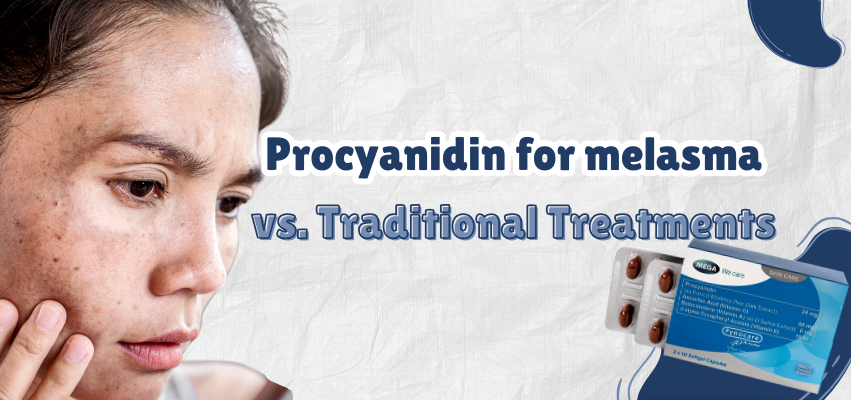
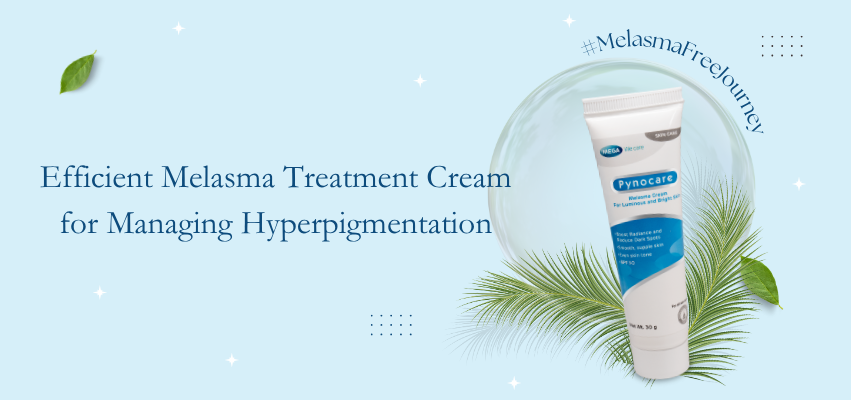
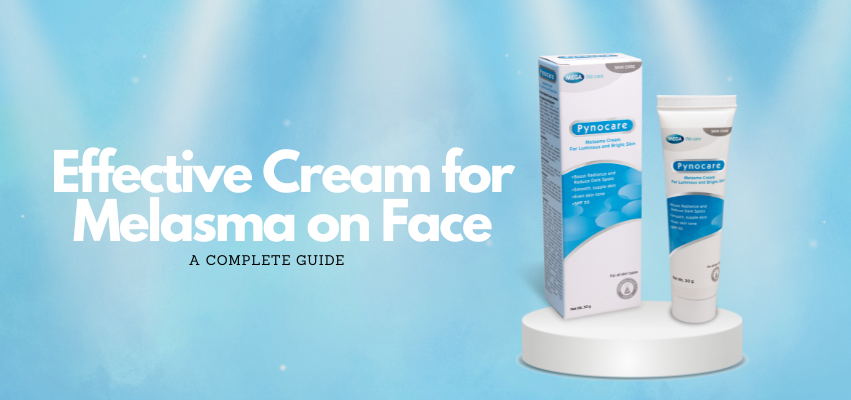
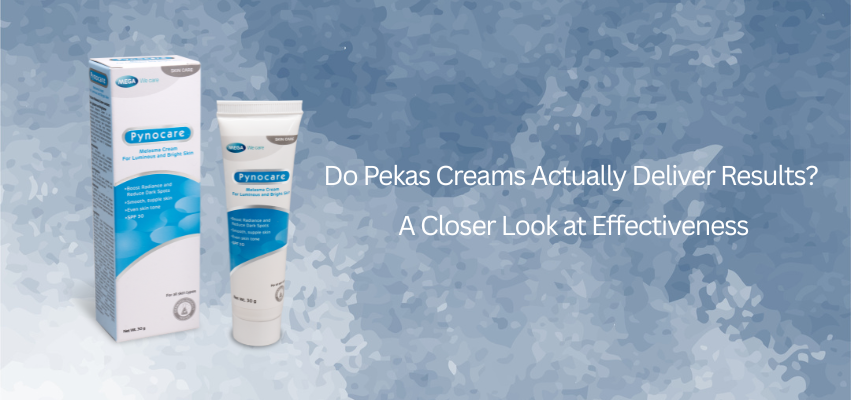


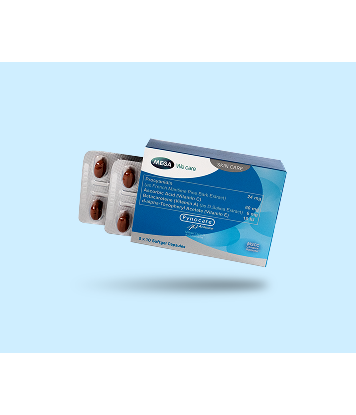













No Comments on Procyanidin for Melasma vs Traditional Treatments